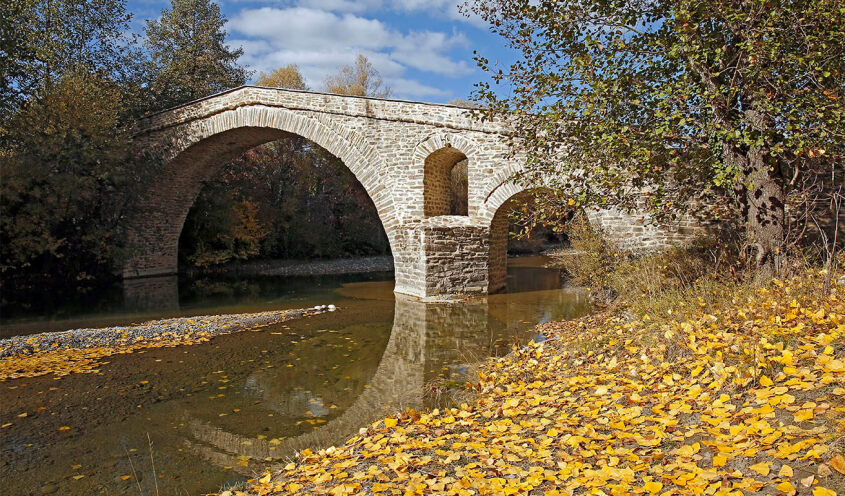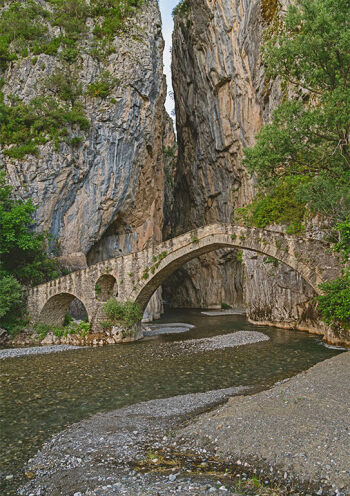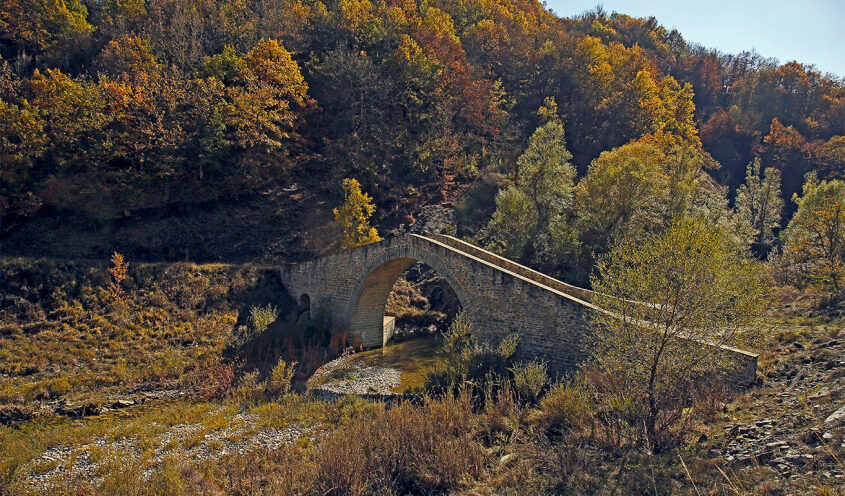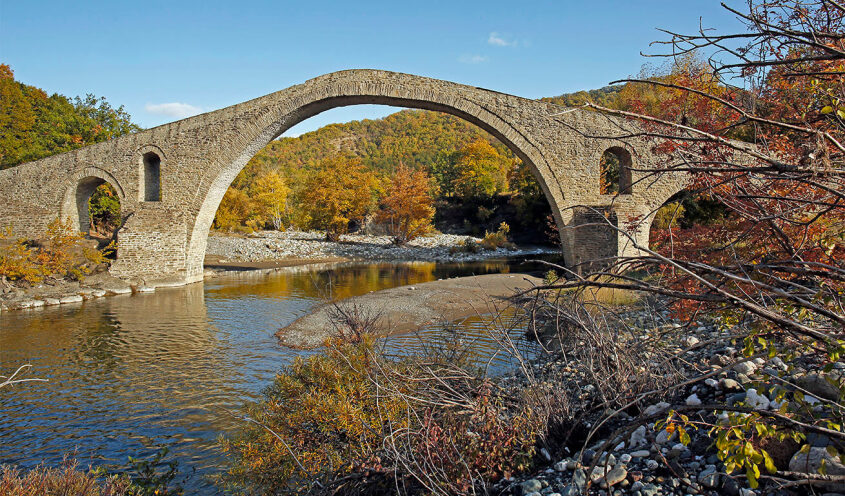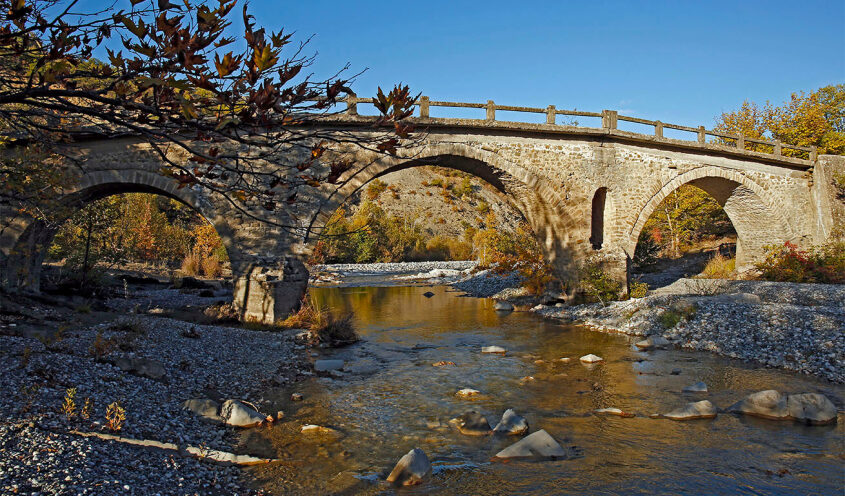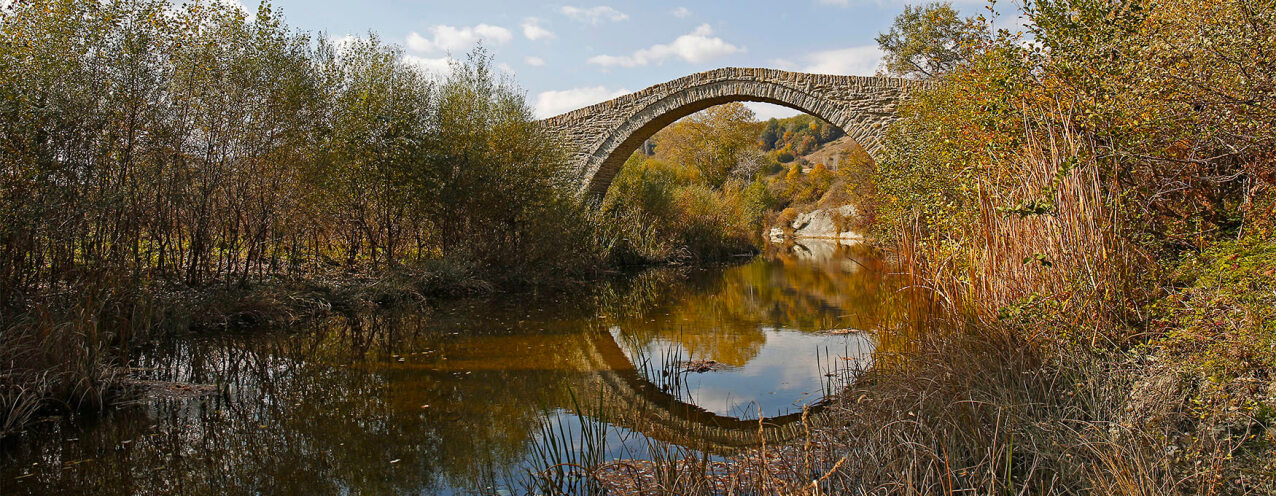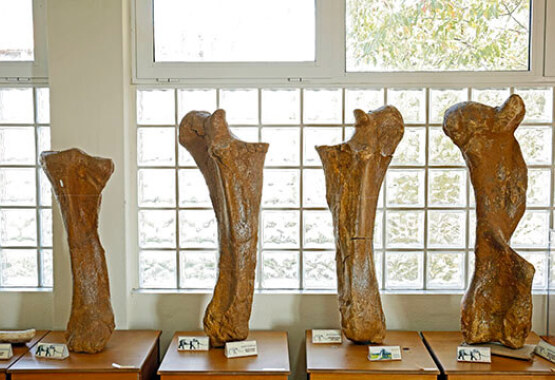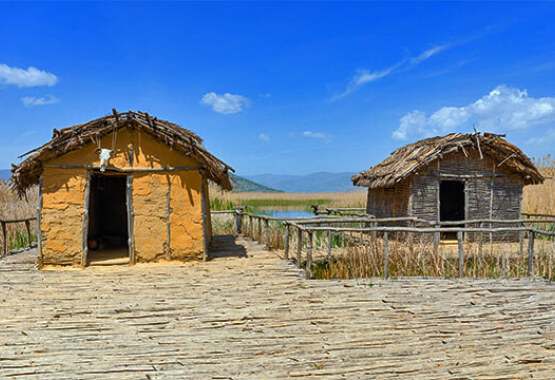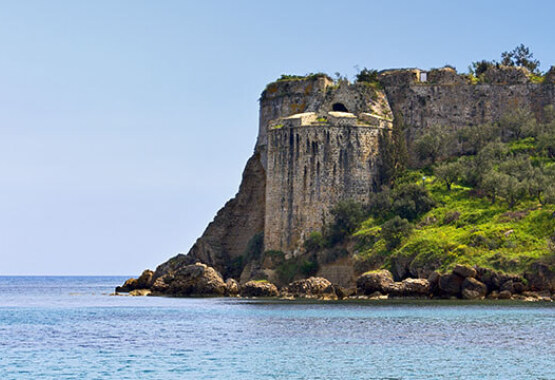
GREVENA
The dense network of small rivers, including Smixiotikos, Velonias, Dotsikiotikos and Pramoritsas, converge to create larger ones, such as Venetikos, Grevenitis and Stavropotamos, to finally end up in Aliakmonas, the largest river that flows entirely within Greece. Frequently impetuous, these rivers created difficulties in communication both between villages and among larger towns. This created the need for bridges, which was met by skilled stone masons, Epirotes and locals. Built mostly between the 18th and the 19th century, the stone bridges of Grevena have been declared scheduled monuments since 1995 and are of course a good reason to visit the area.
The bridge of Stavropotamos over the like-named tributary, which converges with Venetikos River, is roughly 20 km from Grevena, near Kipoureio village.
The bridge was formerly part of the road from Thessaloniki to Ioannina. With four unequal large arches, it has a length of 48 metres and was built around 1880. Close by is Spanos bridge which links the two banks of the Venetikos River.
This five-arch bridge, made from skilfully hewn stones, reaches up to 85 metres in length and is the largest surviving stone bridge in Macedonia. The impressive three-arch bridge of Aziz Aga, which also bridges the Venetikos River, is near the village of Trikomo. The 70-metre-long bridge was built in 1727 as per the local tradition, after a number of hurdles were overcome, and its central arch has a 15-metre span. Near Trikomo, but more difficult to get to, is the double-arch Kagelia bridge stretching for 40 metres, also over the Venetikos River. Ziakas bridge, which was once part of Vasiliki Strata (Royal Road) leading to Thessaly region, is located just outside the village of the same name. It has two uneven arches and a length of 41 metres, spanning the banks of Velonias River.
Portitsa bridge in the village of Spilaio is located at the exit of Portitsa gorge and is perhaps the most beautiful and popular bridge in the area. It has two uneven arches and a length of 34 metres, connecting Spilaio and Trikomo villages, across Venetikos River.
The river bank area next to the bridge is suitable for swimming.
In the centre of Dotsiko village, the single-arch bridge of the same name connects the village’s two neighbourhoods across the Dotsikiotis River. Built around the middle of the 19th century and with a length of 24 metres, it is the only stone bridge in the area that is located within a village. The single-arch bridge of Paliomagero is near the village of Dasyllio and has a length of 23 metres. Built at the beginning of the 20th century, its charm stems from its simplicity and symmetry. On the border with Kozani, between the villages of Anthochori and Klimataki, Pramoritsa bridge spans the banks of the Pramoritsas River, and connects Tsotili with the town of Grevena.
Gavos (or Nidrouzios) bridge is difficult to access, especially in winter. It was built before 1900, bridging the Dotsikiotis River, between the villages of Alatopetra and Prosvoro. It is single-arched, 20 metres in length, and stands out from others in the area due to its flat surface area as well as its isodomic masonry.
The 23-metre-long single-arch Kastro bridge can be reached on foot or on a four-wheel drive vehicle. It is located between the villages of Kastro and Megaro and bridges the Grevenitis River.
The Bridges of Grevena
Eleven bridges of incomparable craftsmanshipThe dense network of small rivers, including Smixiotikos, Velonias, Dotsikiotikos and Pramoritsas, converge to create larger ones, such as Venetikos, Grevenitis and Stavropotamos, to finally end up in Aliakmonas, the largest river that flows entirely within Greece. Frequently impetuous, these rivers created difficulties in communication both between villages and among larger towns. This created the need for bridges, which was met by skilled stone masons, Epirotes and locals. Built mostly between the 18th and the 19th century, the stone bridges of Grevena have been declared scheduled monuments since 1995 and are of course a good reason to visit the area.
The bridge of Stavropotamos over the like-named tributary, which converges with Venetikos River, is roughly 20 km from Grevena, near Kipoureio village.
The bridge was formerly part of the road from Thessaloniki to Ioannina. With four unequal large arches, it has a length of 48 metres and was built around 1880. Close by is Spanos bridge which links the two banks of the Venetikos River.
This five-arch bridge, made from skilfully hewn stones, reaches up to 85 metres in length and is the largest surviving stone bridge in Macedonia. The impressive three-arch bridge of Aziz Aga, which also bridges the Venetikos River, is near the village of Trikomo. The 70-metre-long bridge was built in 1727 as per the local tradition, after a number of hurdles were overcome, and its central arch has a 15-metre span. Near Trikomo, but more difficult to get to, is the double-arch Kagelia bridge stretching for 40 metres, also over the Venetikos River. Ziakas bridge, which was once part of Vasiliki Strata (Royal Road) leading to Thessaly region, is located just outside the village of the same name. It has two uneven arches and a length of 41 metres, spanning the banks of Velonias River.
Portitsa bridge in the village of Spilaio is located at the exit of Portitsa gorge and is perhaps the most beautiful and popular bridge in the area. It has two uneven arches and a length of 34 metres, connecting Spilaio and Trikomo villages, across Venetikos River.
The river bank area next to the bridge is suitable for swimming.
In the centre of Dotsiko village, the single-arch bridge of the same name connects the village’s two neighbourhoods across the Dotsikiotis River. Built around the middle of the 19th century and with a length of 24 metres, it is the only stone bridge in the area that is located within a village. The single-arch bridge of Paliomagero is near the village of Dasyllio and has a length of 23 metres. Built at the beginning of the 20th century, its charm stems from its simplicity and symmetry. On the border with Kozani, between the villages of Anthochori and Klimataki, Pramoritsa bridge spans the banks of the Pramoritsas River, and connects Tsotili with the town of Grevena.
Gavos (or Nidrouzios) bridge is difficult to access, especially in winter. It was built before 1900, bridging the Dotsikiotis River, between the villages of Alatopetra and Prosvoro. It is single-arched, 20 metres in length, and stands out from others in the area due to its flat surface area as well as its isodomic masonry.
The 23-metre-long single-arch Kastro bridge can be reached on foot or on a four-wheel drive vehicle. It is located between the villages of Kastro and Megaro and bridges the Grevenitis River.
